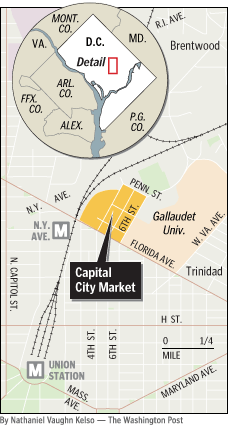Putting industrial uses and residents in close proximity can be a problem

One of the concerns expressed about the New Town redevelopment plan imposed on the Florida Market District through DC City Council legislation is the fact that by putting residents and industrial uses in close proximity, you add all the elements necessary to create significant conflicts.
This is an issue in lower Manhattan, with the conversion of industrial buildings into housing, and an industrial business district into a hotspot of clubs, galleries, and other uses, in places like the Meatpacking District. But it's an issue in other places too.
The New York Times has a story about this kind of interaction occuring in Greenpoint, Brooklyn, "When the Feathers Really Fly."
From the article:
MOST urban dwellers might expect their interactions with chicken, if any, to occur exclusively on a lunch or dinner plate. So when Kate Coats and her husband moved into their apartment in a new condominium building on Greenpoint Avenue in Brooklyn three months ago, they were surprised to be awakened before sunrise by what she described as screeching chickens. It’s not a fun sound at 5 a.m.” ...
The screeching apparently comes from the building next door, the 86-year-old business with the “Live Poultry Slaughter” sign and graffiti that say, “This Place Stinks” on the door of the garage. In the early morning, Ms. Coats said, chickens are delivered to the slaughterhouse in metal crates that crash to the ground, a sound echoed by chickens lustily protesting their fate...
To some, the juxtaposition of a slaughterhouse and a new residential building where condos sell for up to $675,000 is an amusing effect of gentrification. To others, it is grotesque. Several local residents have complained about seeing blood and bird parts on the sidewalk, along with feathers floating in the breeze. Calls to 311 have been numerous, and on a Greenpoint blog, a commenter described the smell emanating from the slaughterhouse as a mix of “death and ammonia.”
For what it's worth, my girlfriend always admonishes me about the romantic idea of backyard poultry, commenting about the early crowing of roosters.
This also happens in more rural areas, where housing developments on former farms bring constituencies with different ideas about what constitutes appropriate land use to "rural" "agricultural" districts.
Ironically, in Baltimore County, non-farming residents are suing a farm which put agricultural land conservation easements on its land, because they opened a farm store to sell the farms products, which is in line with the idea of increasing the revenue to local farmers instead of distributors, and "buying" and "eating" local. Is a farm just land for crops or is it a working business with a variety of revenue streams.
It makes sense to limit these kinds of conflicts, or put into place for reconciling and resolving these conflicts more equally.
Labels: food-agriculture-markets, land use planning, urban design/placemaking, zoning



0 Comments:
Post a Comment
<< Home